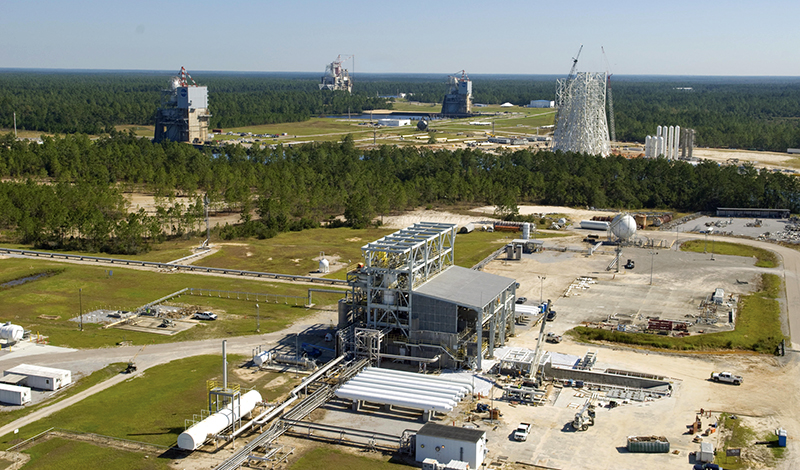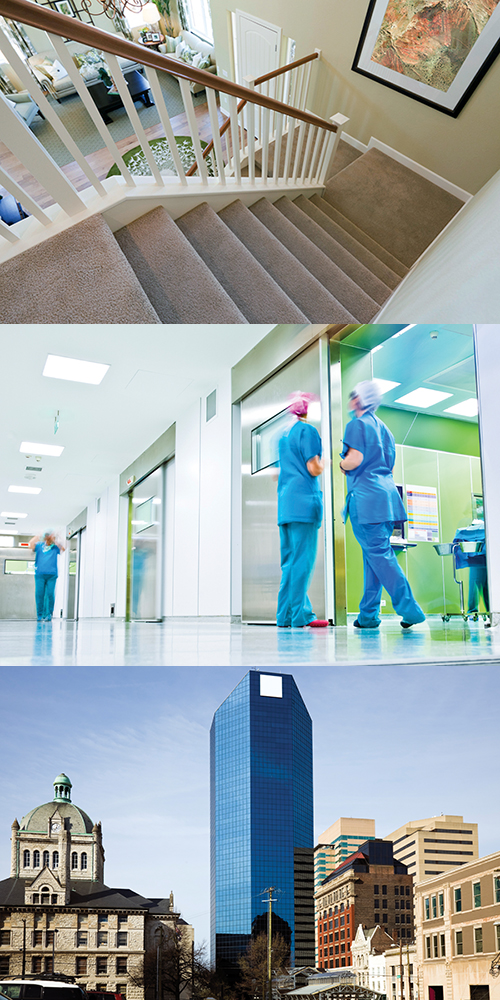
Innovative Coatings Potentially Lower Facility Maintenance Costs
NASA Technology
NASA’s Stennis Space Center is located on 13,500 acres in Hancock County, Mississippi, surrounded by another 125,000 acres that act as a buffer for the deafening roar of rocket engines. It has witnessed the flame and smoke spout from the Saturn V rockets that would carry astronauts to the Moon for the first time, and the space shuttle main engines that would carry them into space more often than any other. More recently, it has hosted the testing of the J-2X engine belonging to the upper stage of NASA’s Space Launch System—technology that will power manned spaceflight during a new era of exploration beyond Earth’s orbit.
Stennis has played a vital role in NASA’s greatest missions and continues to be one of the Agency’s key contributors to aerospace innovation. Over the years, the Center has become a hotbed of collaboration between Government and industry, with organizations such as the Mississippi Enterprise for Technology on site, as well as over 30 companies and Government agencies, driving research and development in space, environmental studies, national defense, and more. The Center is also an Agency and national leader in remote sensing—gathering information without physical contact, as from a satellite.
Often, NASA’s unique facilities and the world-class expertise of its scientists provide benefits outside of the Agency, helping innovators in industry and academia in ways only the Space Program can. In the case of Stennis, the Center that is NASA’s testbed for rocket engine technology is now also—thanks to an enterprising researcher and a private industry partnership—a testbed for a product that seems “too good to be true.”
Technology Transfer
NASA and Stennis senior research scientist Lauren Underwood, working in partnership with the US Department of Homeland Security (DHS), investigated an intriguing class of materials called photocatalytic compounds. When light strikes these compounds, it triggers chemical reactions that break down organic matter—including air pollution, soot, and even potentially dangerous microbes—breaking down these organics into primarily carbon dioxide and water.
While the DHS was studying the materials for national security applications, such as preserving infrastructure against terrorist threats, Underwood saw remarkable potential for NASA applications in space and on the ground. At Stennis, a number of buildings and facilities would benefit from a photocatalytic coating that would eliminate the buildup of grime, reducing the Center’s maintenance costs. In space, the material’s antimicrobial qualities could prove useful for preserving clean, germ-free environments onboard spacecrafts, as well as the International Space Station. But first, Underwood wanted to comprehensively evaluate and validate the technology’s capabilities.
“There is a lot of exciting information that is available and laboratory work that has been conducted on photocatalytic coatings, but not a lot of real-life application research,” she says. “We are working to help validate that these materials are performing the way they are described to perform. It is almost as if they seem too good to be true. If they are so simple and safe, how can they work?”
Underwood led a NASA-funded study of commercial photocatalytic solutions, employing tests ranging from a photographic time series of coated and uncoated surfaces to reflectance measurements utilizing Stennis’ technical expertise in remote sensing.
One of the solutions tested came from Lexington, Kentucky-based Nanocepts Inc. A young company eager to bring a technology popular in Japan to a level of equal recognition in the United States, Nanocepts leapt at the chance to partner with NASA.
“NASA’s strengths are in R&D and technology trends. Since we had a good relationship with manufacturers and developers from Japan, we had the knowledge that Stennis was looking for about the commercial technology, its availability, and which products are best suited for which type of application,” says Balaji Vatsavaya, Nanocepts’ president. “Every time we’ve been to Stennis, it has been a success. It has been a very good partnership.”
Underwood was impressed with the results from the photocatalytic coatings provided by Nanocepts, noting that they performed at a “superior” level. Surface feature evaluations using scanning electron microscopy to assess coating surface coverage and topology characteristics demonstrated that upon application, the test surfaces remained smooth and largely free of cracking which enables the coatings to perform effectively by maximizing the photocatalytic surface area exposed to light. Additionally, once applied to building surfaces outside, over time, the coatings maintained the initial cleanliness of the test surfaces.
Nanocepts’ participation in the Stennis study resulted in the company becoming a NASA Dual Use Technology partner, and the company is now working to build on the validation the collaboration has provided.
“We don’t have access to the kinds of test equipment, facilities, and engineering skills that an agency like NASA has,” says Vatsavaya. “It gives the credibility the technology needs. From an international point of view, me testing it in my lab just isn’t the same as NASA testing it.”
Benefits
Nanocepts’ commercially available, water-based coatings contain titanium dioxide, a powerful photocatalytic element that, when exposed to light, can decompose almost all organic pollutants, destroy many microbes, and eliminate noxious compounds such as ammonia. These capabilities allow the technology to provide a range of benefits in a safe, environmentally friendly way.
First, the coatings are self-cleaning, explains Vatsavaya. They have super-hydrophilic qualities that, during a rain or with a simple spray of water creates a sheeting action, which causes the water not to bead, enabling the easy washing away of any grime and preventing buildup. Even 5–7 years after an application of the material, surfaces remain cleaner than uncoated surfaces. “On bigger buildings, this means a huge reduction in maintenance costs,” Vatsavaya says.
In hospitals, Nanocepts’ products provide an additional benefit: combating bacteria. Studies have shown tens of thousands of deaths occur each year as a result of hospital-acquired infections. Vatsavaya notes that the coatings decompose 99.99 percent of microbes such as E. coli and MRSA, as well as the poisonous endotoxins some of these bacteria can release—thus reducing the chance of life-threatening infections contracted in operating rooms and other hospital areas.
In new buildings, these solutions can break down the volatile organic compounds (VOCs), such as formaldehyde, that can be emitted from building materials, new carpets, and paints. These VOCs have been shown to have damaging health effects when present in high enough quantities. “As long as there is enough light for it to react, these photocatalytic coatings can decompose those toxic compounds,” says Vatsavaya. The reduction of air pollution such as car exhaust and even cigarette smoke are other applications in which the materials can provide significant benefit, he explains.
This technology is currently attracting attention and is engaged in further testing both in the United States and internationally. Vatsavaya says more still needs to be learned before the full potential of his company’s products can be unlocked, and he feels Nanocepts’ NASA partnership holds the key.
“In every area we’ve worked with NASA, the results have been promising,” he says.

Nanocept’s versatile spinoff technology can break down noxious gasses released by new carpeting in homes, destroy microbes responsible for hospital-acquired infections, and help keep buildings free of grime.

Stennis Space Center is the premier rocket engine test facility in the Nation. All three of the Center’s test complexes—the E Test Complex (foreground), the three A Test Complex stands (middle) and the B Test Complex (back) are visible in this aerial photo.













